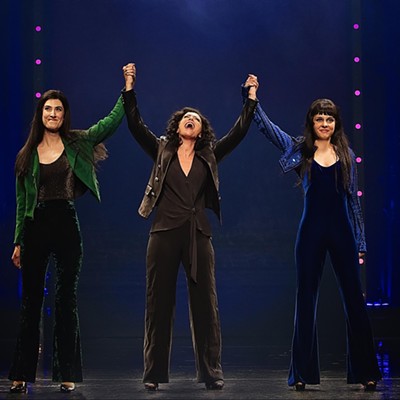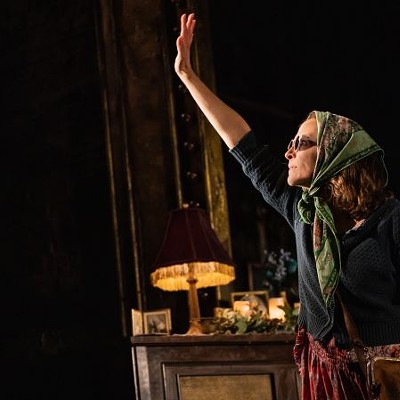As an art reviewer I know that I ought to be impartial, at least at first, but sometimes I fail. As regards “Degas: A New Vision,” which recently opened at the Museum of Fine Arts, Houston, curated by Henri Loyrette, former director of the Musée du Louvre in Paris, and Gary Tinterow, current director of MFAH, I failed. Even before I saw the show, I wrote: “God, if I’m ever stranded on a desert island with only one artist’s work to look at, please let it be Degas.” Now that I’ve been, I can add: “God, please let it be this whole show.”
MFAH is quick to tell us that this is the first comprehensive Degas retrospective since 1988, when an exhibition in which both Loyrette and Tinterow played major parts toured to Paris, New York and Ottawa. For this one, Houston is the only venue in North America, and the exhibit won’t go to Europe. Take that, New York and Paris.
We’ve already had several of these paintings in Houston over the years in one show or another: the iconic In a Café (The Absinthe Drinker), from the Musée d’Orsay; Sulking, from the Metropolitan Museum of Art; Scene from the Steeplechase: The Fallen Jockey, from the National Gallery in Washington, D.C.; and others. They were lovely then, but seeing them in this great all-Degas sweep, without the clamor of their sometimes flashier, but almost always less profound, contemporaries is a powerful thing. One of the most powerful art things I’ve ever experienced, in fact.
I ran into one of Houston’s most eminent living painters at the opening, walking around just about as awestruck as me. He said (more or less): “Might as well quit; it’s all been done already.” And he followed that up with the observation that the paintings all bear close inspection, and that, looking closely, you almost feel as though you’re involved in their creation.
Well, not me when it comes to the painting, since I’m not a painter, but even for me, close inspection of almost any one of them beguiled with subtle but gripping detail. Not the detail of precision, but that of observation, execution and unanticipated insight. The Persian opulence of Mlle Fiocre’s left sleeve in the massive portrait of her in ballet costume; the amazing beauty of the Japanese lacquer chest and the little straw hat of nine-year-old Hortense Valpinçon; the painted energy from the pentimenti of the singer’s changing hand positions in The Song Rehearsal (think Duchamp and the staircase).
This last is one of five remarkable paintings on view that grew out of Degas’s visit to New Orleans in 1872/73. He was the only one of the major French impressionist painters to visit the United States. His mother, Celestine Musson, was born in New Orleans, and his brother, René, moved there after the Civil War, so Degas had lots of family to visit. Though these paintings may have been finished after he returned to Paris, they were certainly conceived and sketched here in America.
The miracle of Degas — one of them anyway — is that the people he shows us are real and in the room with us. No, the other way around. By magic, we’re in the room with them as they continue with their next mundane, perhaps piercing, comment, or their next mundane, certainly telling, gesture. Sometimes they acknowledge us with a glance, a start or a quizzical stare. Often they don’t seem to know we’re even there.
Degas captured life as it was happening and as though he were an invisible recorder, having no impact of his own on the course of events — though better to say course of actions, since the goings-on seldom reached the threshold of “event”: women bathing; exhausted dancers rehearsing; family members ignoring each other over coffee or work.
The sense of their reality is understandable, since many are portraits — even the ones that look like they’re not. But they are portraits with the metaphorical warts as well as the beauty spots. Whatever they’re doing (or not doing) — sitting, reading, working, ignoring each other — is so diabolically compelling that we forget to remember ourselves as we struggle to understand more about them.
I’m a great fan of self-portraits as a way of finding a first connection with an artist. I found the Picasso self-portrait currently on view at the Menil in “Picasso The Line” to be the most magnetic work in that show. (I’d urge everyone to see both and be grateful that we live in Houston this fall.) There are two Degas self-portraits here, a small oil and an even smaller etching, both early, since Degas stopped doing self-portraits early (though he did return to self-portraits when he took up photography near the end of his life). Perhaps he sufficiently figured out who he was earlier than some other artists, or realized that his wasn’t the most interesting story he had to paint. They show an artist who is no self-promoter — quite a contrast to the self Picasso drew.
For some years the two were neighbors in Montmartre in the early 20th century, though there’s no evidence that they ever met. Degas was old and famous. Picasso was young and on the cusp of fame. But Picasso was looking at Degas (there’s even been an exhibition about that), as were others — Matisse and Bonnard, and actually everyone who came after him. The masters of modernism saw their paths already scouted by Degas, a child of the classicism of Ingres and the romanticism of Delacroix. Degas may not have supplanted Cézanne in their eyes, but he certainly stood beside him.
Many of these works appear unfinished because Degas, who seldom intended to sell, moved on as his interest shifted. Though “in process” might be a better term, since he often went back to them after years or decades, and since we, as we look at them, become part of the process of seeing (in the spirit of my eminent painter friend), which is never finished.
In the past I’ve felt that MFAH was not particularly well fixed for Degas. For years I’ve walked by the permanent-collection pieces with hardly a notice, and it’s true that the museum owns no major oils, large or small. But in this context I’m seeing them with a new respect. Two pastels of Russian dancers — no pretty, tutued ballerinas they — are Stravinsky on paper. A pastel landscape (not a genre Degas did much) is almost shockingly phallic. There must be a psychological story there.
But the most forceful of the MFAH works, I think, is Woman Drying Herself, a late (c. 1905) pastel of a nude seen from the back, dominated by a long swath of russet hair. That hair is the culmination of a visual theme that goes all the way back to Degas’s beginnings as an artist, as so many of his themes did. The same red hair is in his early history painting, Scene of War in the Middle Ages, from 40 years earlier, and again in the great Combing the Hair (c. 1896), which once belonged to Matisse, from the National Gallery in London.
Lest anyone fear that I’ve become one of those fawning reviewers who never say anything negative, I’ll note that once again the reflection off the glass that covers many of the works is a problem in the Upper Brown Pavilion, where the exhibition is installed. It’s too bad to bring Degas all the way from Paris, or wherever, and hang him in a gallery where he’s hard to see — like bringing Caruso to a hall with bad acoustics. Better than not bringing him at all, of course, but a shame. Oh, yes, and if any of my facts are wrong, it’s because a guard told me I couldn’t have my ballpoint pen out in the gallery, so I had to remember everything instead of writing it down. I’m blaming it on that, anyway.
Writing in Time Magazine about the 1988 Degas retrospective, Robert Hughes said that such major and massive shows “will be extinct in the twenty-first century.” Not quite yet extinct, perhaps, but it’s pretty certain there won’t be another Degas show like this while most of us are alive. Miss your wedding, miss your kid’s graduation, miss your funeral, but don’t miss “Degas: A New Vision.”
“Degas: A New Vision”
Through January 17, 2017. Museum of Fine Arts, Houston, 1001 Bissonnet, 713-639-7300, mfah.org.
Support Us
Houston's independent source of
local news and culture
account
- Welcome,
Insider - Login
- My Account
- My Newsletters
- Contribute
- Contact Us
- Sign out
[
{
"name": "Related Stories / Support Us Combo",
"component": "11591218",
"insertPoint": "4",
"requiredCountToDisplay": "4"
},{
"name": "Air - Billboard - Inline Content",
"component": "11591214",
"insertPoint": "2/3",
"requiredCountToDisplay": "7"
},{
"name": "R1 - Beta - Mobile Only",
"component": "12287027",
"insertPoint": "8",
"requiredCountToDisplay": "8"
},{
"name": "Air - MediumRectangle - Inline Content - Mobile Display Size 2",
"component": "11591215",
"insertPoint": "12",
"requiredCountToDisplay": "12"
},{
"name": "Air - MediumRectangle - Inline Content - Mobile Display Size 2",
"component": "11591215",
"insertPoint": "4th",
"startingPoint": "16",
"requiredCountToDisplay": "12"
}
,{
"name": "RevContent - In Article",
"component": "12527128",
"insertPoint": "3/5",
"requiredCountToDisplay": "5"
}
]
KEEP THE HOUSTON PRESS FREE...
Since we started the Houston Press, it has been defined as the free, independent voice of Houston, and we'd like to keep it that way. With local media under siege, it's more important than ever for us to rally support behind funding our local journalism. You can help by participating in our "I Support" program, allowing us to keep offering readers access to our incisive coverage of local news, food and culture with no paywalls.
Randy Tibbits is an independent art writer and curator, specializing in the art history of Houston. He is a member of the Board of Directors of CASETA: Center for the Advancement and Study of Early Texas Art and the coordinator of HETAG: Houston Earlier Texas Art Group. He writes art exhibition reviews for Houston Press from time to time.
Trending Arts & Culture
- Best Bets: Earth Day, Noche Caliente and a Spring Festival
- Houston Bookstore Crawl Celebrates Small Businesses and Literary Diversity
- Reviews For The Easily Distracted:
Abigail
-
Sponsored Content From: [%sponsoredBy%]
[%title%]

Don't Miss Out
SIGN UP for the latest
arts & culture
news, free stuff and more!
Become a member to support the independent voice of Houston
and help keep the future of the Houston Press FREE
Use of this website constitutes acceptance of our
terms of use,
our cookies policy, and our
privacy policy
The Houston Press may earn a portion of sales from products & services purchased through links on our site from our
affiliate partners.
©2024
Houston Press, LP. All rights reserved.





